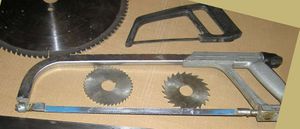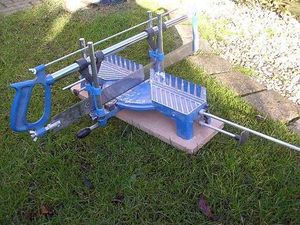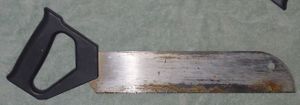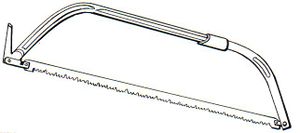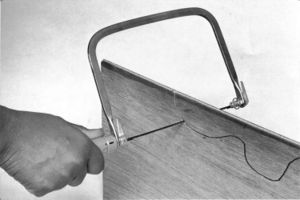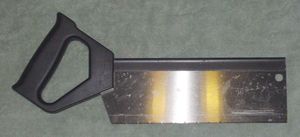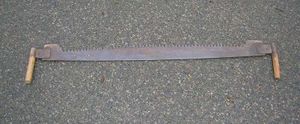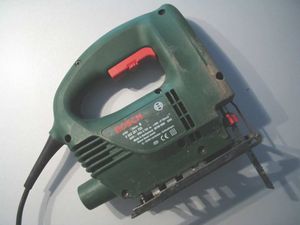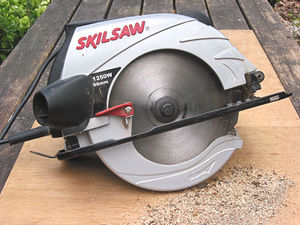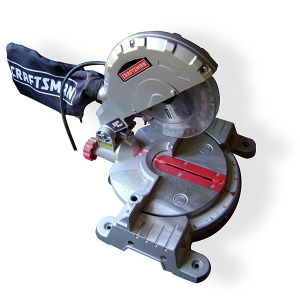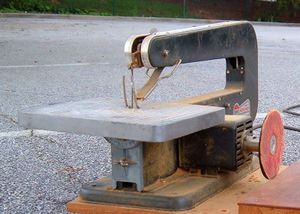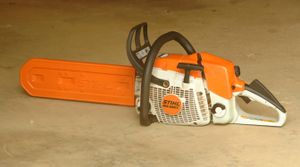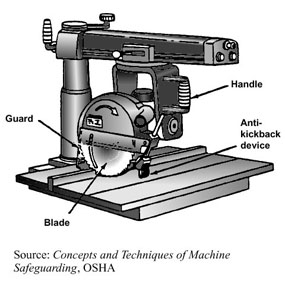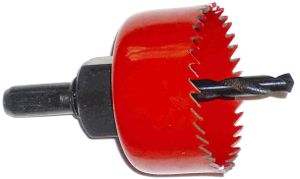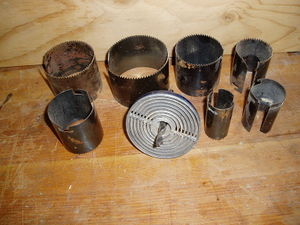Difference between revisions of "Saw"
(→Holesaw: pic) |
|||
| Line 256: | Line 256: | ||
===Holesaw=== | ===Holesaw=== | ||
| − | [[image:Holesaw | + | [[image:Holesaw 0455-6.jpg|thumb|Hole saw]] |
[[image:800px-Adjustable_hole_saw.JPG|thumb|Adjustable holesaw]] | [[image:800px-Adjustable_hole_saw.JPG|thumb|Adjustable holesaw]] | ||
| Line 263: | Line 263: | ||
* One type of holesaw is durable, the other type very weak and must be used with care | * One type of holesaw is durable, the other type very weak and must be used with care | ||
* See main article [[Holesaw]] | * See main article [[Holesaw]] | ||
| − | |||
==Concepts== | ==Concepts== | ||
Revision as of 22:23, 15 June 2010
Hand saws
Hacksaw
- 2 types:
- Junior hacksaw, 6" blades
- Bigger one, 12" blades & other sizes
- Good for metal & plastic
Mitre Saw
- Wood is clamped to the base
- Frame guides saw blade, keeping it at the chosen angle
- Small captive handsaw of some type cuts the timber
- Quite different to the electric mitre saw
Jack Saw
- General purpose construction saw
- Coarse teeth
- Cuts timber, aerated concrete, rigid insulation etc
Toolbox Saw
- Shorter version of jack saw
- Fits in toolboxes
Floorboard Saw
- Has additional teeth on the top side in an arc near the end
- Can saw into floorboards in situ
- The handsaw of choice for cutting into flat surfaces
Azebiki
- Japanese saw with teeth on an outward curve
- good for cutting floorboards
- pic
Bow Saw
- For sawing trees
- The coarse peg teeth usually used cut on both strokes
- 2 blade types for dry wood & green wood.
- Come in various sizes
- Spear & Jackson are well regarded
- To counter sap making the blade sticky, oil blade before use, and wash in water when it gets mucky
- Bowsaw review
Backsaw
- Saws with reinforced back, such as tenon saw
Coping Saw
Crosscut Saw
- Saw optimised for cutting across the grain
Pullsaw
- Any saw that cuts on the pull stroke
- Blade thinner than pushsaws
- Less effort for given progress than pushsaws
- See Japanese saws
Fretsaw
- Saws with very thin blades used for cutting intricate curves
- Manual fretsaw has a very deep frame & short blade
- Blades are extra fine and a bit fragile
- Originally used for cutting latticework
- Metal cutting blades also available
- Spiral blades available, which can cut in any direction but have a wider kerf
- Electric scroll saws are often called fretsaws, and use the same blade type.
Japanese Saws
- Several types are useful for DIY
- Japanese saws normally cut on the pull stroke, enabling use of thinner flexible blades. Less kerf means less physical work to achieve a given cut.
- Tend to cost much more than western style saws
Gents Saw
Keyhole Saw
- Very narrow blade for tight places
Tenon Saw
Two-man saw
- aka pit saw
- Long slightly curved blade with a handle on each end
- Double the sawing power
- Very long stroke
- About the only DIYer accessible saw that can cut whole mature trees into lengths
Wire saw
- Flexible saw wire with a handle on each end
- Mostly used for veterinary uses (bones, horns)
- Exceptionally good access properties for difficult cuts, can thread through and round things
- Not expensive
- Not stocked by many DIY tool suppliers
- Coils into a tiny size, one could carry 10 in a pocket easily
- A popular tool in survival kits due to tiny size
- Note the silverline one is not very flexible, and breaks if coiled.
Tile saw
- an abrasive saw
- the one shown has a drill bit built into one end
Pruning saw
- For cutting small trees and limbs
- Frameless
- Gives better access than a bowsaw
Power Saws
Jigsaw
- Low cutting speed
- Can cut curves
- Steer by rotating the saw, never push sideways
- Quality varies greatly
- Cheap & midrange jigsaws:
- Performance generally anything from patchy to dire
- Blades wander & bend badly
- Cost of ruined wood over the lifetime of a cheap or midrange jigsaw is likely to exceed the cost of a better saw
- Not possible to cut a straight line using a guide fence, as they need regular direction correction
- Good jigsaws:
- Constrain the blade with rollers
- Can cut straight lines
- Much less prone to blade bending, but not immune
- Various types of blade available:
- Coarse, medium, fine
- Blades for wood, metal, plastic, leather, paper products
- Flush cutting
- Knife
- Grit
- Varying teeth pitch
Circular saw
- Fast cutting
- Cuts straight lines only
- Good general purpose DIY saw
- Riving knife prevents kickback
- Blades with high number of teeth can produce very smooth cuts
- Normally supplied with a guide fence
- Depth of cut and angle can be preset
- Max possible cutting depth is reduced with angled cuts
- Hand held, bench type and cordless circular saws are all used for DIY
Mitre Saw
- Compound mitre saws' blades can swivel in 2 axes for compound angle cuts.
- Fast cutting
- Fairly small max cut width
- Hence mostly used for cross cutting
- Circular saw blade
- Cutting head swivels to cut at various angles
- Cutting head tilts to give cuts angled in 2 axes
- The quality of these machines varies widely
- Plastic bases found on budget machines bend slightly under force, misaligning cuts.
- On poor quality machines the saw head may be subject to some unwanted movement
- Pushing the saw can violently shatter the fence with some budget machines
- Cut width can be roughly doubled if the workpiece is turned over to complete the cut from the other side. The result is pretty good, but not perfect, if care is taken to get good alignment for the second half of the cut.
- Laser makes aligment of timber much quicker than running an eye across the blade
- See Mitre saw review
Sliding Mitre saw
- Mitre saw with cutting head that slides to cut wider timber
- Enables longer cuts to be made in larger timber
Flipsaw
- Mitre saw with a sawhead that flips over to give either a mitre saw or benchsaw
Cutoff Saw
- Look somewhat like mitre saws, but with no angle adjustments
- Cuts at precisely 90 degrees
- Workpiece clamp included
- Abrasive grit blade usually used
- Primarily used on metalwork
Scroll Saw
- Vibrating blade can be touched without injury
- Modern version of fretsaw
Spiral saw
- eg Rotozip
- Can plunge into solid materials then drill in any direction
- Can not withstand a lot of side force
- Limited uses due to poor performance with a lot of uses
- OK for very soft materials
- Die Grinders can use 1/8" spiral saw blades, but such thin blades are rather weak
- Spiral saws taking 1/8" blades also take die grinder accessories - check speed ratings
Table saw
- Circular blade
- Fast feed rate
- Plastic or wood pushers are used to keep hands away from blade
- Old table saws lack guarding
Bandsaw
- Uses a blade consisting of a continuous loop of spring steel, with cutting teeth on one edge. This rotates around two aligned wheels (one of them driven), and passes vertically through a cutting table.
- Coarse, fine and omnidirectional blades available
- A typical DIY bandsaw blade of 12mm width allows straight and curved cuts down to about 150mm radius to be comfortably made. Narrower blades allow tighter curves to be cut, but they are more vulnerable to breakage.
- For accuracy of cutting, the 'set' of the teeth on a bandsaw blade should be properly maintained. Once the 'set' has gone, the blade will tend to wander.
Handheld Bandsaw
- A miniature hand held version of a band saw (picture)
- Anyone used one?
Tile saw
- Small table saw with diamond grit circular tile blade
- Water cooled blade
- Makes very clean cuts in tiles, concrete etc
- Can cut small strips of tile neatly too
- Replacing the blade might allow it to do other jobs too
- Tile cutter
Reciprocating saw
- Powered version of jack saw or hacksaw
Chainsaw
- Relatively high risk saw
- Protective clothing is wise
- Basic training is wise
- Correct type of oil important
- Blade should not contact soil
- Tip must not touch workpiece, or the tool throws at the user
- Chainsaw art is becoming increasingly popular
Radial arm saw
Another type of sliding circular saw
Holesaw
- Coarse tooth holesaws cut wood & plastic, and some cut metals
- Abrasive core drills are used on masonry
- One type of holesaw is durable, the other type very weak and must be used with care
- See main article Holesaw
Concepts
- TPI
- number of teeth per inch
- Kerf
- The width of the sawn slot
Tooth Materials
- Hardpoint
- Hardened steel teeth. Low cost sawblade type. The teeth wear, requiring regular blade relacement. The teeth can occasionally break off too.
- TCT
- Tungsten Carbide Tipped. Highly durable TC tips are brazed to the blade. The result is a blade that cuts much faster, and cuts harder materials with ease. Blades last a long time before dulling.
Early TC saws in the 1940s suffered from the tips shattering easily in use. Todays TC saws avoid this by using tips made from a matrix of TC grit set in a relatively soft metal. This gives the toughness of TC without the tendency to shatter.
Don't fit a non-TC blade into a power saw designed for TCT blades. The steel teeth will not be able to cope with the workload, and accidents can result.
Materials
Wood
Coarse blades give fast cutting but a rough result. Finer toothed blades give a cleaner result but slower progress. The subject of wood saw tooth geometry is a good deal more complex than just this, and covers questions of tooth spacing, tooth cutting material, tooth geometry and other matters.
Laminates
Melamine in particular tends to break along the sawn line, giving a very poor edge. Methods used to combat this:
- Score with a stanley knife before cutting
- Place scrap sheet material on top of the workpiece
- Place the workpiece face down, sat on scrap material.
- Cut it 1/4" oversize and plane down, using the plane at an angle to prevent any lifting of the melamine.
- Stick tape on the workpiece before cutting
Steel
Steel can be cut by a fine toothed saw, or other methods such as nibbler or grinder. It can also be melted by a welder or high temperature cutting torch.
Hardpoint saws wear quite rapidly when cutting steel.
Non-ferrous metals
These can be cut by a fine toothed hand saw or a fine tooth power saw. Mitre saws can use coarse teeth, but go easy with the pressure.
Plastics
For hand cutting a fine toothed blade is needed. Power saws may also use a coarse blade if the pressure on the workpiece is kept gentle, and the plastic is strong enough to not bend much during cutting.
Thin unsupported plastics tend to bend into a coarse blade and get broken. Options are to use a fine tooth blade, or to turn a coarse TCT blade round so it runs backwards.
Power sawing plastic can result in the blade heating up and this affecting the cut, but this isn't likely to happen with just sawing one small item. Some power saws have a lower speed setting to eliminate the possibility.
Reviews
To Do
Plywood saw Rip saw Saw set Pics dado saw
See Also
- Sawboard
- Clamps
- Sharpening
- Wiki Contents
- Wiki Subject Categories
